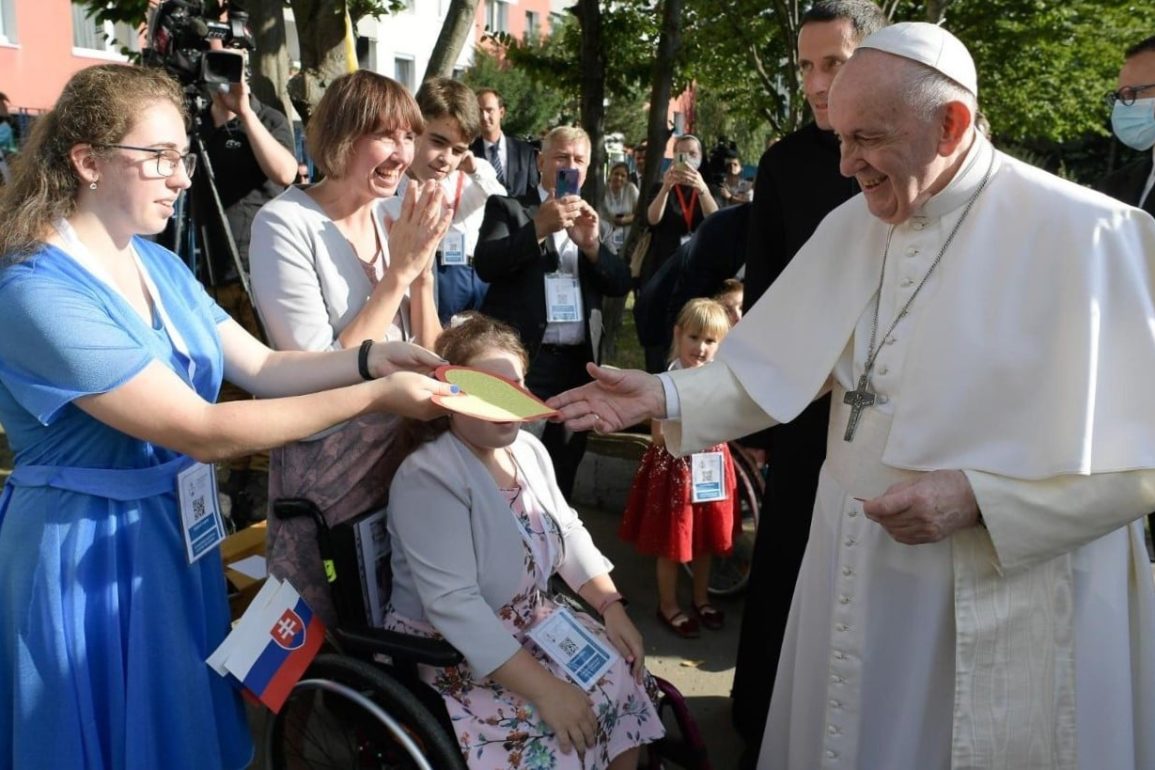After lunch, in the Apostolic Nunciature this September 13, 2021, around 3:45 pm Pope Francis went, on a private visit, to the Bethlehem Center of the Missionaries of Charity in Bratislava, in the neighborhood of Petrzalka.
The Pope said a few words off-the-cuff and added that he was very happy to be there and grateful for the welcome he received. He also thanked the Sisters for the work they do “of hospitality, help, and accompaniment,” as well as the fathers, mothers, and children present. He also thanked the Lord, “because when we are together and so happy, the Lord is with us.” In this connection, he reminded us that God accompanies us “always,” “on the journey of life,” especially, “in ugly moments.”
The Holy See reported that the Holy Father was received by the Superior of the Bethlehem Center, who showed him some of the rooms of the Center, which receives the homeless that are assisted by the Sisters of Mother Teresa’s Congregation. During his visit, the Holy Father talked with the Center’s residents and with the Sisters. There was a chorus of children in the patio, who sang joyful songs. Before taking his leave, the Pontiff prayed the Hail Mary with those present, imparted his Blessing, and gave the community a gift.
“I thank the Sisters of Charity for their witness. I thank the people that collaborate with them. I pray for you; please, do so for me. May the Lord bless you and may the Virgin protect you,” Pope Francis wrote in the Book of Honour.
The Pope’s Gift: The Virgin and Child

Made of porcelain, of modern Italian production, the unusual iconography, of this most delicate Virgin and Child holding a bunch of grapes, derives from a known picture of renowned Pierre Mignard, kept at present in the Louvre of Paris, although an older version is found in the central panel of the famous Polyptych of Pisa, painted by Masaccio in 1426 for the church of Carmel of that city, at present in London’s National Gallery.
Underscored in both pictures is the symbolism of the grape as Eucharistic Blood of Christ’s Passion, although in the Old Testament bunches of grapes already symbolized not only joy and friendship but also Israel and the People of God.
In the same way, therefore, if in the New Testament the vine is the Kingdom of Heaven and its fruit is the Eucharist, the true trunk of God’s vine is His Son Jesus, who in fact in John’s Gospel (15:1-8) proclaims: “I am the vine, you are the branches. Those who abide in Me and I in them bear much fruit.”
If grapes in the Bible (and hence, also in art) have become little by little the distinct sign of the Messiah and of all those that recognize and follow Him, the Virgin Mary is the fruitful vine par excellence, given that she is the Spouse that introduced the King of Kings in the world.
This is, then, the theme that the rare iconographic subject of the “Virgin of the Grapes” develops. A theme that touches all, as through those grapes we are indissolubly united to the “vine” that is Christ, as it is precisely through the fidelity of the “vine shoots” that His vital Blood reaches up to the last grape.
Moreover, the wine that in the Eucharist becomes the Redeemer’s Blood is the fruit of many grapes gathered from all parts and pressed in the “winery of adversity.” A “wine,” or “blood of the grape’ — as it is called in Hebrew — that speaks of the unity of the Church, sealed in an alliance based on the love of Christ.
The Bethlehem Center
For more than 20 years, the international community of Sisters of Mother Teresa of Calcutta has been taking care of the homeless, the indigent, those in need of help, and, especially, the sick.
The two-story small building, former daycare center, offers beds, hot meals, and washrooms. Attended on the ground floor are basic needs and here is room for short stays; on the second floor, a room is reserved for long-term care or the gravely ill. Next to it is a Chapel dedicated to the Immaculate Heart of Mary.
Thanks to people’s generosity the Sisters can provide care, clothes, basic needs for those that live on the street and knock at the door. Near the Center is the parish church of the Holy Family, consecrated in 2005 after Saint John Paul II’s visit, who beatified two martyrs of Communism there in 2003: Sister Zdenka Schelingova and Greek-Catholic Bishop Vasil Hopko.
Translation by Virginia M. Forrester










